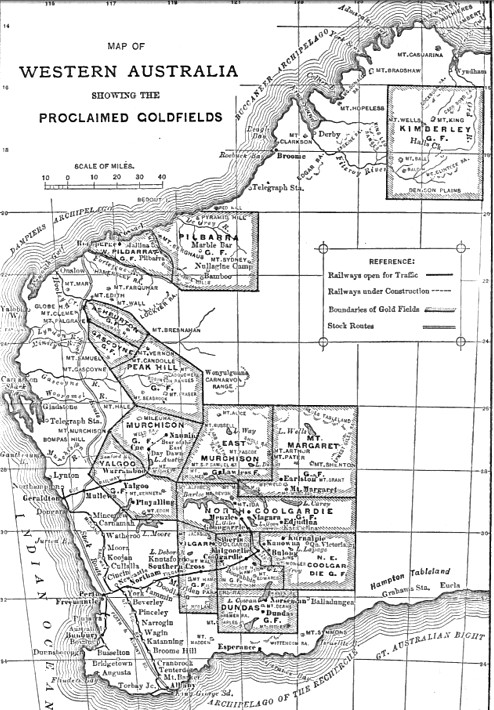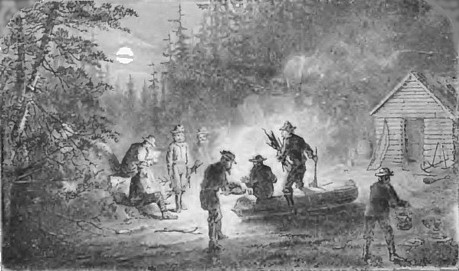THEORIES OF ORIGIN
Of course, several theories have been mooted, the most fanciful of
which have naturally been those of the working miner himself. The fact that
the gold-bearing cement is in places overlain by a considerable thickness of
partially-consolidated rock has led to the supposition that the deposit was
a "deep lead;" while the resemblance to a conglomerate has caused more than
one Africander to liken it to the "blanket" of the
Witwatersrand
gold deposits. The latter is
an immense shore-deposit of gold-bearing conglomerates, now covered by a
series of later sediments. Its dimensions, comparative homogeneity and
persistence are in striking contrast to the narrow, restricted, irregular
patches of detritus which have been described as occurring in West
Australia. This total unlikeness renders unnecessary any discussion of a
fancied similarity of origin. But because this alluvium disappears under an
overburden of rock,* the Australian digger easily fancies he is working a
deposit similar to the "deep leads" with which he became familiar at Ballarat, for example. A distinguished government geologist from a
neighboring colony visited Kanowna in October, 1897, and gave authority to
the term "deep lead" by using it himself. "Deep" it may be, for that is a
comparative adjective, but a "deep lead" in the technical sense it most
assuredly is not. On the Forest Hill divide, in Placer County, California,
and at Oreswick, in the Ballarat district, Victoria, the typical "deep
leads" occur. They are, as is well known, old (Miocene) gold-bearing river
channels, which have been saved from erosion by a cap of lava. The lava
probably overflowed the original surface as a steaming mud, and is now found
consolidated into a volcanic rock sufficiently hard to need little timbering
when penetrated by underground workings.
The cement deposits of West Australia occur under an overburden of "made ground;" that is to say, both the deposit itself and all the material under which it dips are of distinctly detrital origin, the products of weathering and erosion accumulated in shallow depressions of the much decomposed surface of granite or diorite. It is the placer of a country destitute of running water. The climatic conditions and the physiography of the Coolgardie gold-fields have been carefully described, in order to make it evident why these deposits differ from those of more favored countries, like California or New Zealand. Surely it is not in keeping with the scientific method to seek for fantastic or far-fetched explanations, when processes in operation to-day are able to supply an adequate understanding of the observed facts.
The quartz of the cement is subangular; it has evidently undergone very little attrition, and suggests, therefore, that it has not traveled far. On comparing it with the matrix of neighboring veins, an identity appears obvious. The examination of the topography renders highly probable the derivation of the one from the other. The cementing material is similarly found to be the clay resulting from the decomposition of the rock encasing the quartz-veins, and varying according to the composition of that rock, whether it be granite or diorite. Finally, the gold particles which have rendered the cement worth mining are found to be identical in fineness and physical appearance with the gold of the neighboring veins, and their scarcely-rounded edges invite the conclusion that the gold has not been borne far from the place of its origin. The comparatively unclassified condition of the deposits is in keeping with the evidence afforded by the material of which they are composed. The absence of running water on this desert plateau has prevented any such sifting-process as in other regions leads to the deposition of well-defined layers of clay, gravel and gold upon a clean bed-rock. It is an exceptional illustration of the working of those agencies to whose unceasing play is due the configuration of the earth's surface; it is geological action in its most instructive form.
WATER-SUPPLY
The early history of the gold-fields of West Australia is the record of a
struggle to exist amid conditions which were inimical to human life on
account of the scarcity of water. That great necessity has been, in some
sort satisfied by the energetic action of the government, supplemented by
private enterprise. The gold-fields are now dotted over with
condensing-plants, which turn the brine of the wells into water fitted for
the use of man and beast. Existence is thus rendered endurable; but the
mining industry is still handicapped by an item of cost unknown in more
favored regions. The water of the country is salt, sometimes almost to the
point of saturation. Sea-water contains 31 per cent, of salts,
three-quarters of this percentage being common salt, the chloride of sodium.
At Menzies, in September, 1897, I found one of the two important mines of
that district using water which contained 17 per cent, of salts, and the
manager informed me that in December evaporation increased the amount to 30
percent. For this liquid he paid 25 shillings per thousand gallons. It came
from a neighboring "soak." The condensed (distilled) water, bought for use
in the boilers, cost 1 per hundred gallons. Milling in a ten-stamp-mill was
carried on at an average cost of 30 shillings or $6 per ton, the item of
water alone amounting to 13 shillings or $3.25 per ton.
Under these conditions a wet mine becomes a source of revenue. Many properties at Kalgoorlie, unable to find paying ore, lessened the expenses of development by selling their water to those that had mills. The price varied according to the season. At the Great Boulder Main Reef mine, for example, the lowest price paid for water during 1897 was 3. 10s. per thousand gallons, and the highest 11. 5s. This was piped from neighboring shafts, and had not passed through the condenser; it therefore had the character of sea-water, but it was four times as saline. During the wet season, some of the depressions filled with such accumulations of detritus will receive more water than they can hold, and then the eye becomes gladdened for a few days by the sight of water running over the surface. As it becomes diminished by evaporation it disappears from view, but will be found to linger in the rock-holes, where the supply is maintained by the slow drainage of the surrounding porous area. These are called by the aborigines "guamma" holes. The life of such natural wells depends, of course, on the dimensions of the water-bearing depression and upon. the relative porosity of the deposit which it drains. These supplies are in their nature uncertain. The next and more important source of supply is found at the ordinary drainage level of the country, namely, the horizon where the oxidation of the surface ceases and the relatively hard unoxidized rock offers a partial barrier to the free descent of the waters which have percolated through the overlying formation. The depth of this zone will depend upon the permeability of the superficial rock formation. It varies from 40 feet at Earlston to 202 feet at Kalgoorlie. A characteristic section is that given by the well put down on Reserve 3096, Coolgardie, where the Gold-fields Water Supply Department sunk 165 feet and found 7 feet of sand, 47 feet of conglomerate and 111 feet of decomposed granite. The water was found at the base of the last, just above the unaltered granite.
Continue on to:
RUSSIA: The Ural Gold Fields
Return To:
Important Gold Mining Regions Worldwide


